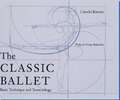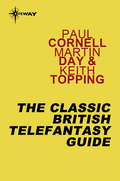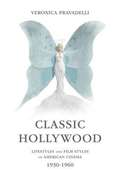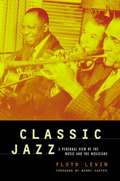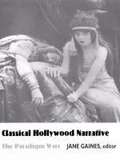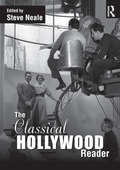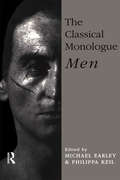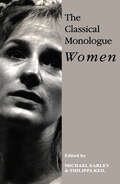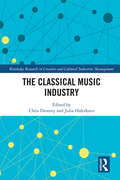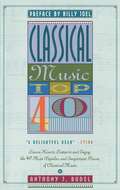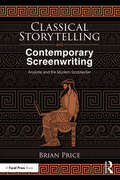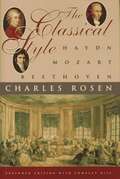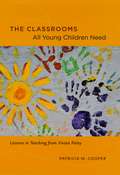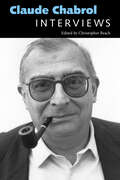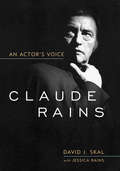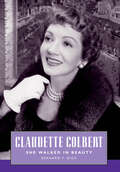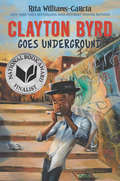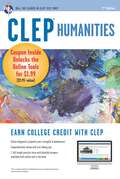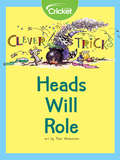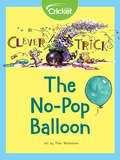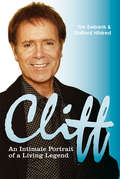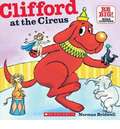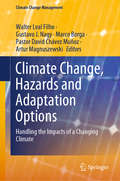- Table View
- List View
The Classic Ballet: Basic Technique And Terminology
by Lincoln Kirstein Muriel Stuart Carlus DyerA warm welcome back to this beloved classic! For decades the standard text for ballet technique, this book--first published in 1952--presents a beginner's guide to basic movements, steps, and terminology. Written by the staff of the School of American Ballet, it builds on the Russian tradition of Anna Pavlova and reflects the dance style of George Balanchine.
The Classic British Telefantasy Guide
by Paul Cornell Martin Day Keith ToppingThe Classic British Telefantasy Guide is derived from the second edition of The Guinness Book of Classic British TV with various corrections and a revised introduction to bring it up to date. It was written when the Internet barely existed, and at a time when few books had been published on the subject. This is, however, by no means a new or completely revised version of the original material - too much time has passed, and if we were to start reworking and correcting the text now, it would probably never be finished! Instead, Classic British Telefantasy is an electronic reprint of some of the authors' earliest work, repacked for a new format and, perhaps, a new age.
Classic Hollywood: Lifestyles and Film Styles of American Cinema, 1930-1960
by Michael Meadows Veronica PravadelliStudies of "Classic Hollywood" typically treat Hollywood films released from 1930 to 1960 as a single interpretive mass. Veronica Pravadelli complicates this idea. Focusing on dominant tendencies in box office hits and Oscar-recognized classics, she breaks down the so-called classic period into six distinct phases that follow Hollywood's amazingly diverse offerings from the emancipated females of the "Transition Era" and the traditional men and women of the conservative 1930s that replaced it to the fantastical Fifties movie musicals that arose after anti-classic genres like film noir and women's films. Pravadelli sets her analysis apart by paying particular attention to the gendered desires and identities exemplified in the films. Availing herself of the significant advances in film theory and modernity studies that have taken place since similar surveys first saw publication, she views Hollywood through strategies as varied as close textural analysis, feminism, psychoanalysis, film style and study of cinematic imagery, revealing the inconsistencies and antithetical traits lurking beneath Classic Hollywood's supposed transparency.
Classic Jazz: A Personal View of the Music and the Musicians
by Floyd LevinAn award-winning jazz writer has pulled together 50 years' worth of his articles, which appeared mostly in jazz magazines, to take readers into the world of jazz and its musicians. This personal view of a rich American music weaves in anecdotal material, primary research, and music analysis into every chapter. 51 photos. 10 line illustrations.
The Classical Hollywood Cinema: Film Style and Mode of Production to 1960
by David Bordwell Janet Staiger Kristin ThompsonHow films are conceived,planned, and produced leaves a mark upon the films, directly and structurally. The relations between film style and mode of production are, according to the authors, reciprocal and mutually influencing. The authors trace such topics as style, economics, and technology over time, demonstrating how significant changes occurred in Hollywood from the earliest days through the sixties.
Classical Hollywood Narrative: The Paradigm Wars
by Jane M. GainesSince the 1970s film studies has been dominated by a basic paradigm--the concept of classical Hollywood cinema--that is, the protagonist-driven narrative, valued for the way it achieves closure by neatly answering all of the enigmas it raises. It has been held to be a form so powerful that its aesthetic devices reinforce gender positions in society. In a variety of ways, the essays collected here--representing the work of some of the most innovative theorists writing today--challenge this paradigm.Significantly expanded from a special issue of South Atlantic Quarterly (Spring 1989), these essays confront the extent to which formalism has continued to dominate film theory, reexamine the role of melodrama in cinematic development, revise notions of "patriarchal cinema," and assert the importance of television and video to cinema studies. A range of topics are discussed, from the films of D. W. Griffith to sexuality in avant-garde film to television's Dynasty.Contributors. Rick Altman, Richard Dienst, Jane Feuer, Jane Gaines, Christine Gledhill, Miriam Hansen, Norman N. Holland, Fredric Jameson, Bill Nichols, Janey Staiger, Chris Straayer, John O. Thompson
The Classical Hollywood Reader
by Steve NealeThe Classical Hollywood Reader brings together essential readings to provide a history of Hollywood from the 1910s to the mid 1960s. Following on from a Prologue that discusses the aesthetic characteristics of Classical Hollywood films, Part 1 covers the period between the 1910s and the mid-to-late 1920s. It deals with the advent of feature-length films in the US and the growing national and international dominance of the companies responsible for their production, distribution and exhibition. In doing so, it also deals with film making practices, aspects of style, the changing roles played by women in an increasingly business-oriented environment, and the different audiences in the US for which Hollywood sought to cater. Part 2 covers the period between the coming of sound in the mid 1920s and the beginnings of the demise of the `studio system` in late 1940s. In doing so it deals with the impact of sound on films and film production in the US and Europe, the subsequent impact of the Depression and World War II on the industry and its audiences, the growth of unions, and the roles played by production managers and film stars at the height of the studio era. Part 3 deals with aspects of style, censorship, technology, and film production. It includes articles on the Production Code, music and sound, cinematography, and the often neglected topic of animation. Part 4 covers the period between 1946 and 1966. It deals with the demise of the studio system and the advent of independent production. In an era of demographic and social change, it looks at the growth of drive-in theatres, the impact of television, the advent of new technologies, the increasing importance of international markets, the Hollywood blacklist, the rise in art house imports and in overseas production, and the eventual demise of the Production Code. Designed especially for courses on Hollywood Cinema, the Reader includes a number of newly researched and written chapters and a series of introductions to each of its parts. It concludes with an epilogue, a list of resources for further research, and an extensive bibliography.
The Classical Monologue (M): Men
by Michael Earley Philippa KeilThe Classical Monologue in two volumes, one for men and one for women, is a fresh selection of the best speeches from the repertoire of the classical theatre, from the Greeks to the beginning of the 20th century. These great dramatic monologues--from all periods and styles, all varied in tone and genre--make an indispensable actor's companion for auditioning, rehearsing and performing. Each monologue is accompanied by textual notes explaining any unusual vocabulary or syntax, and by commentary in which the editors offer interpretative points and practical advice in preparing the speech for performance. Both beginners and experienced actors will find The Classical Monologue a treasury of theatrical riches waiting to be released on stage.
The Classical Monologue (W): Women
by Michael Earley Philippa KeilFirst Published in 1993. Routledge is an imprint of Taylor & Francis, an informa company.
The Classical Music Industry (Routledge Research in Creative and Cultural Industries Management)
by Chris Dromey Julia HaferkornThis volume brings together academics, executives and practitioners to provide readers with an extensive and authoritative overview of the classical music industry. The central practices, theories and debates that empower and regulate the industry are explored through the lens of classical music-making, business, and associated spheres such as politics, education, media and copyright. The Classical Music Industry maps the industry’s key networks, principles and practices across such sectors as recording, live, management and marketing: essentially, how the cultural and economic practice of classical music is kept mobile and alive. The book examining pathways to professionalism, traditional and new forms of engagement, and the consequences of related issues—ethics, prestige, gender and class—for anyone aspiring to ‘make it’ in the industry today. This book examines a diverse and fast-changing sector that animates deep feelings. The Classical Music Industry acknowledges debates that have long encircled the sector but today have a fresh face, as the industry adjusts to the new economics of funding, policy-making and retail The first volume of its kind, The Classical Music Industry is a significant point of reference and piece of critical scholarship, written for the benefit of practitioners, music-lovers, students and scholars alike offering a balanced and rigorous account of the manifold ways in which the industry operates.
Classical Music Top 40
by Anthony RudelIn this informal and informative guide, Rudel leads listeners through the 40 most essential and popular compositions from the Four Seasons to Rhapsody in Blue, explaining the musical structure of each passage and highlighting special themes or elements to listen for as the music continues.
Classical Storytelling and Contemporary Screenwriting: Aristotle and the Modern Scriptwriter
by Brian PriceSince we first arrived on the planet, we’ve been telling each other stories, whether of that morning’s great saber-tooth tiger hunt or the latest installment of the Star Wars saga. And throughout our history, despite differences of geography or culture, we’ve been telling those stories in essentially the same way. Why? Because there is a RIGHT way to tell a story, one built into our very DNA. In his seminal work Poetics, Aristotle identified the patterns and recurring elements that existed in the successful dramas of his time as he explored precisely why we tell stories, what makes a good one, and how to best tell them. In Classical Storytelling and Contemporary Screenwriting, Brian Price examines Aristotle’s conclusions in an entertaining and accessible way and then applies those guiding principles to the most modern of storytelling mediums, going from idea to story to structure to outline to final pages and beyond, covering every relevant screenwriting topic along the way. The result is a fresh new approach to the craft of screenwriting—one that’s only been around a scant 2,500 years or so—ideal for students and aspiring screenwriters who want a comprehensive step-by-step guide to writing a successful screenplay the way the pros do it.
The Classical Style: Haydn, Mozart, Beethoven
by Charles RosenThis book treating the three most beloved composers of the Vienna School is considered basic to any study of classical-era music. Drawing on his rich experience and intimate familiarity with the works of these giants, Charles Rosen presents his keen insights in clear and persuasive language.<P><P> Winner of the National Book Award
Classical Traditions In Science Fiction
by Brett M. Rogers Benjamin Eldon Stevensor all its concern with change in the present and future, science fiction is deeply rooted in the past and, surprisingly, engages especially deeply with the ancient world. Indeed, both as an area in which the meaning of "classics" is actively transformed and as an open-ended set of texts whose own 'classic' status is a matter of ongoing debate, science fiction reveals much about the roles played by ancient classics in modern times. Classical Traditions in Science Fiction is the first collection in English dedicated to the study of science fiction as a site of classical receptions, offering a much-needed mapping of that important cultural and intellectual terrain.
The Classrooms All Young Children Need
by Patricia M. CooperThe book identifies a pedagogical model organized around two complementary principles: a curriculum that promotes play and imagination, and the idea of classrooms as fair places where young children of every color, ability, and disposition are welcome.
Claude Chabrol: Interviews (Conversations with Filmmakers Series)
by Christopher BeachClaude Chabrol (1930–2010) was a founding member of the French New Wave, the group of filmmakers that revolutionized French filmmaking in the late 1950s and early 1960s. One of the most prolific directors of his generation, Chabrol averaged more than one film per year from 1958 until his death in 2010. Among his most influential films, Le Beau Serge, Les Cousins, and Les Bonnes Femmes established his central place within the New Wave canon. In contrast to other filmmakers of the New Wave such as Jean-Luc Godard and Eric Rohmer, Chabrol exhibited simultaneously a desire to create films as works of art and an impulse to produce work that would be commercially successful and accessible to a popular audience. The seventeen interviews in this volume, most of which have been translated into English for the first time, offer new insights into Chabrol’s remarkably wide-ranging filmography, providing a sense of his attitudes and ideas about a number of subjects. Chabrol shares anecdotes about his work with such actors as Isabelle Huppert, Gérard Depardieu, and Jean Yanne, and offers fresh perspectives on other directors including Jean-Luc Godard, Fritz Lang, and Alfred Hitchcock. His mistrust of conventional wisdom often leads him to make pronouncements intended as much to shock as to elucidate, and he frequently questions established ideas and normative attitudes toward moral, ethical, and social behaviors. Chabrol’s intelligence is far-reaching, moving freely between philosophy, politics, psychology, literature, and history, and his iconoclastic spirit, combined with his blend of sarcasm and self-deprecating humor, gives his interviews a tone that hovers between a high moral seriousness and a cynical sense of hilarity in the face of the world’s complexities.
Claude Rains: An Actor's Voice (Screen Classics)
by David J. Skal Jessica RainsLate in Claude Rains's distinguished career, a reverent film journalist wrote that Rains "was as much a cinematic institution as the medium itself." In Claude Rains: An Actor's Voice, noted Hollywood historian David J. Skal draws on more than thirty hours of newly-released Rains interviews to create the first full-length biography of the actor nominated multiple times for an Academy Award for Best Supporting Actor. This portrait of a universally respected Hollywood legend also benefits from the insights of his daughter, Jessica Rains, who provides firsthand accounts of the enigmatic man behind her father's refined screen presence and genteel public persona. With unprecedented access to episodes from Rains's private life, Skal tells the full story of the consummate character actor of his generation.
Claudette Colbert: She Walked in Beauty (Hollywood Legends Series)
by Bernard F. DickClaudette Colbert's mixture of beauty, sophistication, wit, and vivacity quickly made her one of the film industry's most famous and highest-paid stars of the 1930s and 1940s. Though she began her career on the New York stage, she was beloved for her roles in such films as Preston Sturges's The Palm Beach Story, Cecil B. DeMille's Cleopatra, and Frank Capra's It Happened One Night, for which she won an Academy Award. She showed remarkable prescience by becoming one of the first Hollywood stars to embrace television, and she also returned to Broadway in her later career. This is the first major biography of Colbert (1903–1996) published in over twenty years. Bernard F. Dick chronicles Colbert's long career, but also explores her early life in Paris and New York. Along with discussing how she left her mark on Broadway, Hollywood, radio, and television, the book explores Colbert's lifelong interests in painting, fashion design, and commercial art. Using correspondence, interviews, periodicals, film archives, and other research materials, the biography reveals a smart, talented actress who conquered Hollywood and remains one of America's most captivating screen icons.
Clayton Byrd Goes Underground
by Rita Williams-Garcia<P>Clayton feels most alive when he’s with his grandfather, Cool Papa Byrd, and the band of Bluesmen—he can’t wait to join them, just as soon as he has a blues song of his own. But then the unthinkable happens. Cool Papa Byrd dies, and Clayton’s mother forbids Clayton from playing the blues. And Clayton knows that’s no way to live. <P>Armed with his grandfather’s brown porkpie hat and his harmonica, he runs away from home in search of the Bluesmen, hoping he can join them on the road. But on the journey that takes him through the New York City subways and to Washington Square Park, Clayton learns some things that surprise him. <P>From beloved Newbery Honor winner and three-time Coretta Scott King Award winner Rita Williams-Garcia comes a powerful and heartfelt novel about loss, family, and love that will appeal to fans of Jason Reynolds and Kwame Alexander.
CLEP® Humanities Book + Online (CLEP Test Preparation)
by Robert Liftig Marguerite BarrettEarn College Credit with REA’s Test Prep for CLEP Humanities Everything you need to pass the exam and get the college credit you deserve. REA leads the way in helping students pass their College Board CLEP exams and earn college credit while reducing their tuition costs. With 25+ years of experience in test prep for the College-Level Examination Program (CLEP), REA is your trusted source for the most up-to-date test-aligned content. Whether you’re an adult returning to finish your degree, a traditional-age college student, a military service member, or a high school or home-schooled student looking to get a head start on college and shorten your path to graduation, CLEP is perfect for you. REA’s expert authors know the CLEP tests inside out. And thanks to our partners at Proctortrack (proctortrack.com/clep), you can now take your exam at your convenience, from the comfort of home. Prep for success on the CLEP Humanities exam with REA’s personalized three-step plan: (1) focus your study, (2) review with the book, and (3) measure your test-readiness. Our Book + Online prep gives you all the tools you need to make the most of your study time: Diagnostic exam: Pinpoint what you already know and what you need to study.Targeted subject review: Learn what you’ll be tested on.Two full-length practice exams: Zero in on the topics that give you trouble now so you’ll be confident and prepared on test day.Glossary of key terms: Round out your prep with must-know vocabulary.REA is America’s recognized leader in CLEP preparation. Our test prep helps you earn valuable college credit, save on tuition, and accelerate your path to a college degree.
Clever Tricks: Heads Will Role
by Liz HuyckTwo coins are face-up side by side. What will happen if you roll one coin around the top of the other? Will the head be right-side up? Or upside-down?
Clever Tricks: The No-Pop Balloon
by Liz HuyckCan you command a balloon not to pop? You can, if you're just a bit sneaky first.
Cliff: An Intimate Portrait of a Living Legend
by Stafford Hildred Tim EwbankFifty years ago he was just the boy Harry Webb, performing in a local youth club. Now he is Sir Cliff Richard, the first rock star to be knighted, with a massive international fan base and a top ten hit in each of the last six decades. Yet, despite his huge public persona, the man himself remains a reserved and private figure.Unflinching in its portrayal of the man behind the musical icon, this revealing biography marks fifty years of music from the first British pop star. His fellow musicians, co-stars, directors and Cliff himself talk candidly about his musical ascendance, the women in his life, his religious beliefs and his lasting regret that he has never broken America.
Clifford at the Circus
by Norman BridwellEmily Elizabeth and Clifford the big red dog have a day at the circus that they will always remember.
Climate Change, Hazards and Adaptation Options: Handling the Impacts of a Changing Climate (Climate Change Management)
by Walter Leal Filho Gustavo J. Nagy Marco Borga Pastor David Chávez Muñoz Artur MagnuszewskiThis book addresses the issue of climate change risks and hazards holistically. Climate change adaptation aims at managing climate risks and hazards to an acceptable level, taking advantage of any positive opportunities that may arise. At the same time, developing suitable responses to hazards for communities and users of climate services is important in ensuring the success of adaptation measures. But despite this, knowledge about adaptation options, including possible actions that can be implemented to improve adaptation and reduce the impacts of climate change hazards, is still limited. Addressing this need, the book presents studies and research findings and offers a catalogue of potential adaptation options that can be explored. It also includes case studies providing illustrative and inspiring examples of how we can adapt to a changing climate.
